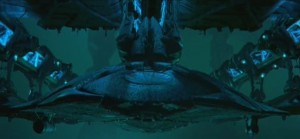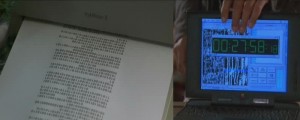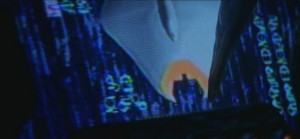[Editor’s note: Are you fan of all things ID4? Don’t miss the Independence Day Overview, our downloadable commentary on the movie. Get it now!]
Few instances of technology in movies have received more scorn than the Independence Day “hacking” scene, in which Jeff Goldblum’s David Levinson uses a mid-90s PowerBook to send a virus that takes down an entire alien star fleet. The scene regularly makes any list of ridiculous uses of computers and technology, and is the internet’s go-to example of bad Hollywod tech. So in honor of a few colonies that no one thought could defeat the greatest empire the world has ever known, I’m here today to fight for the little guy, to defend the indefensible: Why the Independence Day hacking scene could have worked.
There are really two issues that need to be addressed: compatibility and security. Compatibility is whether or not any code, much less a crippling virus, could plausibly have made it from David Levinson’s mind and keyboard into the alien computer system. This is an issue from both a hardware and a software standpoint. Security is whether or not, given a compatible system, David Levinson could really write a virus that does what’s shown.
Hardware Compatiblity: Alien Serial Bus
The first and most obvious hurdle that a would-be xeno-hacker has to conquer is a physical one: in order for one computer system to affect another, it needs some way of getting information from point A to point B. In the security world, an “air gap” is a security measure that relies on this limitation to prevent unauthorized access. If there’s no physical connection between your system and your adversary’s system, there’s nothing an attacker can do about it. The air gap between David, sitting in a hangar in Area 51, and the alien mother ship in orbit, is a large one to say the least.
Note however, that an air gap is rarely perfect. If someone uses portable media (like a USB drive) on an internet-facing computer and then uses the same media on your “air gapped” network, the air gap has just closed. That code can potentially make its way onto your network (like say, the one that controls your nuclear centrifuges). In the movie, that’s exactly what happens: the hackers compromise a presumably trusted “media device” (the crashed Fighter), and use it to gain access to the entire system.
Of course, that only gets them half way there. They’ve moved data from the Fighter to the Mother Ship, but David prominently (and for the makers of ID4, profitably) uses a PowerBook Pro to do his hacking. This issue is the source of most of the scorn heaped on ID4, because any human-made computer is going to be wildly different in fundamental design than any alien space ship.
This becomes less ridiculous, though, when we consider the background of the alien craft in question. The Fighter has been in Area 51 for 40 years. It is the most technologically significant machine in the world and the brightest minds of multiple generations have probably had their hands in this endeavor. The head of the lab makes it clear that they’ve been rebuilding it for decades, even if the “gizmos and gadgets” haven’t been powered on until the arrival of the rest of the Fleet. There’s no doubt that every millimeter of that craft has been taken apart and diagrammed, with full schematics available.
They also know what the aliens look like, so they have an idea of xeno-ergonomics. From this, it’s likely they could have inferred where on the ship the alien interfaces and I/O ports are – essentially, what an Alien Serial Bus looks like and how it might work. It’s likely that the Area 51 team developed some form of human-to-alien compatible adapter long before the fleet even arrived. That adapter would mean that a signal generated by the PowerBook could make its way into the computer system of the alien Fighter, and then from the fighter to the alien Mother Ship.
Software Compatibility: Xeno-Linux
Of course, PCs and Macs sometimes have compatible ports too, and they can’t talk to each other. Just having a path for your signal doesn’t mean that the signal is going to mean anything to the other system when it arrives. The most common argument against the ID4 hacking scene runs along the lines of “If a Mac and a PC aren’t compatible, it certainly isn’t going to be compatible with an alien’s operating system (insert Linux joke here).”
This is where the “team of brightest minds” thing comes into play again. In the movie, the mission of Area 51 is to figure out how the craft works and how to fly it. Even if they haven’t previously got enough power to actually fly the spacecraft, it’s likely that the computer system could be at least booted up and tinkered with. Because none of the mechanical systems could be powered on, the computer on the ship would be by far the most studied piece of equipment on the craft. Getting data in and out of the Fighter’s computer would have been heavily researched, and it’s likely they already had a good idea of at least the basic building blocks of code used by the system.
The arrival of David Levinson is the last piece of the puzzle—he has already figured out at least part of the alien’s computer language by looking at the binary code the aliens send through our satellites. Even before he knows about Area 51, he’s created an interface on his computer for translating the alien computer language into a semi-usable form. In that sense, the PowerBook is really just a human-friendly GUI to access the Fighter’s computer system. From there, Levinson can use Area 51’s preexisting research to translate the Mac’s code into Alien++ and send it via the Fighter’s communications to the mother ship.
Security: The Trusting Alien
The next question is, even assuming that David Levinson can write and transmit usable code to the alien ship, could he really take the whole fleet down with just one virus? Remember, all the code he writes has to do is A) shut down the shields and B) spread itself to other alien ships (and C) display a kick-ass skull and cross bones.)
The “shut-down shield” code would presumably be the easiest, since the Fighter has a similar shield and David is shown shutting it down in the hangar. The “spread itself” part depends on how good the alien security is. The naïve view is that their computer security would be as overwhelming as the rest of their defensive technology. This tongue-in-cheek critique of the movie from the security-centric website “InfoSec Island” is telling: “the remotest possibility that a human-written virus could affect their superior system is completely without substance.” [emphasis added].
The assumption that the alien technology is superior to ours across the board is unfounded. We know that their space travel and weapons technology is far superior, but computer security is a very different ball of wax. As the US military is learning in a painful way, having the best planes and biggest bombs doesn’t mean your systems will be the most secure.
The assumption behind having computer security is that other people might try and do something they’re not supposed to on your system. The problem is that we know nothing about their culture’s propensity or even capacity for this sort of behavior—the assumption of widespread and systematic dishonesty on computer systems is a very human one.
Perhaps their culture is so rigidly honest that lying, even to a computer system, is utterly taboo. The captured alien certainly isn’t reticent to tell the President all of their plans. Perhaps, like in Harry Turltedove’s World War series, their culture was united under one empire so early in their history that certain aspects of war never really became an issue, and they are woefully unprepared for an asymmetric “insider”-attack. In a society where individuals can communicate mind to mind (as the aliens can), would unauthorized access to computers even be a thing? There’s no reason to assume that just because one aspect of their technology is powerful that another will be as well developed.
What’s clear from the movie, however, is that their security sucks. Centralization is generally a bad sign from a computer security standpoint. Their system is so heavily centralized that an external agent (the Mother Ship) can manipulate an individual Fighter to a ridiculous level of granularity, even overriding the system and opening the cockpit doors. Any human security expert would lose their mind if they discovered than an F/A-18 was designed so that a remote signal could lower the landing gear or open the cockpit hatch without the pilot’s consent – the potential for abuse by an enemy is too great.
Their behavior in the movie shows that they have simply not considered the possibility that humans have access to their technology. They are arrogant enough to use our own satellites and assume we won’t try and reverse engineer their signal—so arrogant, in fact, that the signal isn’t even encrypted. It’s also clear that the aliens have a particular blind-spot for simple, obvious solutions: they can’t even break Morse code when it’s used by the human forces. Even their largest and most important invasion ships are designed with a massive and fatal single point of failure so large that a drunken Randy Quaid can hit it.
With all of that apparent, it’s possible that their computer security is non-existent. Perhaps the ships are all just linked together, prepared to accept whatever codes and commands are given to them, confident in the good-intentions of the party sending those commands. The virus might be as simple as:
virus.exe if(shield) then shield=FALSE for all(connected_host) upload virus.exe to connected_host execute virus.exe on connected_host display(skull.bmp) play(evil_laugh.wav)
Hacking a computer means gaining physical access with a compatible computer and sending the right code to defeat the system’s defenses. In Independence Day, the crashed fighter and forty years worth of research into it provides the necessary hardware and software background, and the alien’s arrogance provides the nuclear-bomb sized hole in their computer defenses. When David Levinson arrives on scene at Area 51, 99% of the leg work of figuring out the interface and system code is already done, either by him or by Area 51’s scientists. The virus doesn’t have to be perfect, either. As David admits, the virus won’t knock out the shields completely, just turn them off for a few minutes while the aliens figure out what happens and reset the system. Given access to an “insider” threat like the crashed Fighter and a team of the Earth’s most brilliant scientists, it’s conceivable that the infamous “PowerBook hacking an alien space craft” scene could happen to an alien fleet completely unprepared for a cyber-threat .
The aliens came to conquer a supposedly inferior species—just as the haters attack our beloved film by telling you that a PowerBook pro with 16MB of RAM can’t hack an entire alien space fleet. But we believers are fighting for our right to live, to exist. We’re going to live on. We’re going to survive. Today, we celebrate Independence Day.
Reading about Independence Day making you want to watch it? Get The Overview: Independence Day and watch it with the writers from Overthinking It.





Just when I thought I couldn’t love this movie–or my country–any more than I do already, this post came along.
Plausible, yet wildly improbable. Regardless, this was a fun article.
Excellent! Two points:
1) Well, actually… it would probably be skull.gif, since it’s animated.
2) I would take your compatibility argument a step further. You say that since they’ve had the Fighter 40 years, the “brightest minds” have had a long time to figure it out. But that 40-year period coincides with our own development of modern computer hardware and software. It’s not a stretch to say everything we have now (in 1996) is actually based on (or at least heavily influenced by) what those guys learned by examining the Fighter. Like how Dyson in ‘Terminator 2’ says that Skynet is largely based on what they learned from the recovered ‘Terminator’ chip. There may be a little divergent evolution, but basically David’s PowerBook has the same hardware and software DNA as the alien systems.
This common DNA theory helps with the virus aspect too, if we stretch the analogy. Real viruses can be passed between species that are genetically similar, as long as the right factors are in place. So basically, David is giving the Mother Ship the computer version of bird flu, for which their systems have no natural immunity, a la ‘War of the Worlds.’
According to a recent discussion on Reddit, there’s a deleted scene to exactly that effect – computers were invented based on the alien technology from the ship.
Bravo for that “Well, actually” :D
Problem to your theory that modern computers where developed based on the technology of the aliens software and hardware is, that the modern computers where based on inventions of Charles Babbage (England) and todays computers from Konrad Zuse (Germany) the Z1,Z2, Z3, Z4 and other ones.
Both inventions happened before (Konrad Zuse 5 years prior and Charles Babbage more than a 100 years prior) the Area 51 incident.
They didn´t had the Alien spaceship to work with. This means that the brightest people working on the space ship, didn´t figure out anything useful on the software side.
It would be true if the computer would have been invented from the Americans.
If only you said “were” instead of “where”. If only.
Human tech being based on recovered Area 51 tech does solve some of the problems with this ridiculous scenario, but it still doesn’t explain why hostile aliens would let us have access to that technology in the first place, rather than having it self-destruct as soon as it’s no longer in their control…
The aliens are strongly telepathic. Ergo, they would not have any concept of individuality. Ergo, there are no alien “hackers.” Theirs is a collective intelligence and no individual could get away with committing a crime even if such an individualist notion ever crossed its mind. As soon as one of them thought “I’ll write a virus” everyone else in the civilization would know about it. Indeed, they probably don’t even have the pronoun “I.” Everything is “we.”
Therefore, it would never occur to them to develop Norton Antivirus for Aliens.
If they’re confident enough to go around attacking civilizations on other planets, then they are smart enough to consider the consequences of doing so.
Thank you very much for this great analysis. It got me thinking about this particular alien species a little more and one thing came up: how come they have to rely on human satellite systems anyway? If you attack an inferior enemy, it seems foolish to rely on their own technological systems. They should have been at least able to place some of their ships around Earth for communication purposes, if not their own comm satellites. Come to think of it, their whole technology seems very simple in some ways (strong centralization, no drones, no nanotechnology or similar advances) and quite advanced in others (force fields, persumed faster-than-light travel, presumed stealth for prior recon missions).
Combine this with the rather odd goal of their mission: They came quite a long way and use an awful lot of energy wiping out the local population in order to exploit our planet’s resources. Does our planet even have resources that are not found in other, uninhabited places in the solar system (other than life, which they are not interested in)?
These two things lead me to a hypothesis: The ID aliens are scavengers, in the sense that they have acquired parts of their technology from other species or planets. This accounts for their very simple approach to partly advanced weapons or defense systems. It is conceivable that there are parts of their technology that they don’t even understand themselves. It reminds me of the rebel Incas in Vilcabamba, scavenging muskets from the Spaniards and using them without being able to properly clean and load them, leading to weak shots – which would, of course, still suffice to defeat a more technically inferior civilization. By that analogy, the ID aliens may be the weaker members of a larger network of Galactic civilizations, going around using brute force and bits and pieces of advanced weaponry to destroy those who seem inferior to them.
This would also explain a) any severe gaps in their computer systems as well as b) the lack of any further development in technology between the 1950s and 1990s (they seemingly do not even recognize that a 40-year-old fighter drops in on them).
I am not too familiar with the secondary literature to ID – did anybody else have that suspicion before me?
Interesting comments, but if these aliens are able to use the technology they’ve supposedly scavenged, they’ve got to be fairly intelligent. How long are the technologies they scavenge going to work if they don’t know how to repair or maintain them? I don’t think an advanced space-faring civilization would go trekking across the universe on some jury-rigged space ship thrown together by MacGuyvering aliens. Comparing them to what people even less advanced than us did when exploring the earth in the past is probably pointless, too.
There is the problem of embedded systems, why engineer would have the fighter space ship run of a general purpose computer rather then a embedded system only meant to do the tasks expected of the ship. To a engineer making a space fighter you want to strip the system down as much as possible to get away with the smallest, lightest and most power effect system as possible while on a large mothership you don’t have the same constraints.
I mean think about it for a second, do you honestly think anyone could hack NASA’s ground computers from the on-board computer of one the Space Shuttles? The Shuttle computers are literally nothing more then glorified programmable calculators, and the NASA ground computers are only talking to the on-board computer to retrieve data not commands. This is not a security feature it is just NASA engineers never say any point in adding the functionality of their ground computers being able to run commands from the Space Shuttle.
I’m not sure what you think NASA’s methods have to do with the methods of aliens traveling between star systems. I think it’s safe to say that the alien’s fighters would be highly networked. In fact, they most likely would be drones. There would be no point in having an alien pilot on board in the first place.
This article wins on so many levels, but the best part is “Jeff Goldblum” crossing the Delaware. I’m not the only one who saw that, right?
“he has already figured out at least part of the alien’s computer language by looking at the binary code the aliens send through our satellites”
This is your mistake. If the aliens are sending code to earth satellites to control them, it would be earth code, not alien code. Jeff Goldblum could not ‘learn all about alien code’ from examining the messages they send to take control of earth’s satellites since those messages would have to be mimics of human-made code the satellite would understand.
There are also problems with your “Powerbook as a GUI to the captured fighter tech”. The alien tech would be running zillion times faster than a 1990s Powerbook. In order to get that virus onto the alien mothership thru the fighter Jeff is going to have to do it quickly enough that the aliens don’t have time to intercept or fix his attack. So using the Powerbook to control the fighter tech is a ridiculous kludge, like using a morse-code tapper to program a Powerbook. To even have a chance of getting ahead of the aliens time-wise with his virus attack, Jeff would not only have to be able to program the fighter directly, he’d probably need to go several layers deep into its tech, from high-level alien interfaces (after-all aliens need friendly interfaces, too) right down to its low-level equivalent of assembly language. This isn’t a corporation’s IT department who might not notice the breach for days, weeks or months, this is military tech. There would be an army of aliens tasked solely with snuffing out cyber-attacks ASAP.
By the way, one more thing I’d like to mention is that aliens who have conquered interstellar travel are not going to be stupid. If it is possible for Will Smith to capture an alien fighter, then it’s a scenario that the aliens have considered. Why wouldn’t they simply not allow any lost fighters to operate at all, or not allow them access to their network? Why would any useful technologies onboard not self-destruct as soon as the fighter pilot is no longer in control of it?
This scenario can be plausible only to people who know nothing about computer hardware, software,the logic and mathematical system in which it may be based, humans use the binary system, it is simple, yes, but it is no guarantee that an advanced civilization would opt for it (what if they use a fuzzy logic system for example?), furthermore, anyone reaching earth from light years away, sure has thousands if not millions of years of technological advance compared to humans, I wouldn’t expect people from the dark ages to reverse engineer stuff from the 1990’s as much as I wouldn’t expect humans from the 20th century to reverse engineer alien stuff, it is moronic to even think there would be a 0.001% possibility of that ever happening!